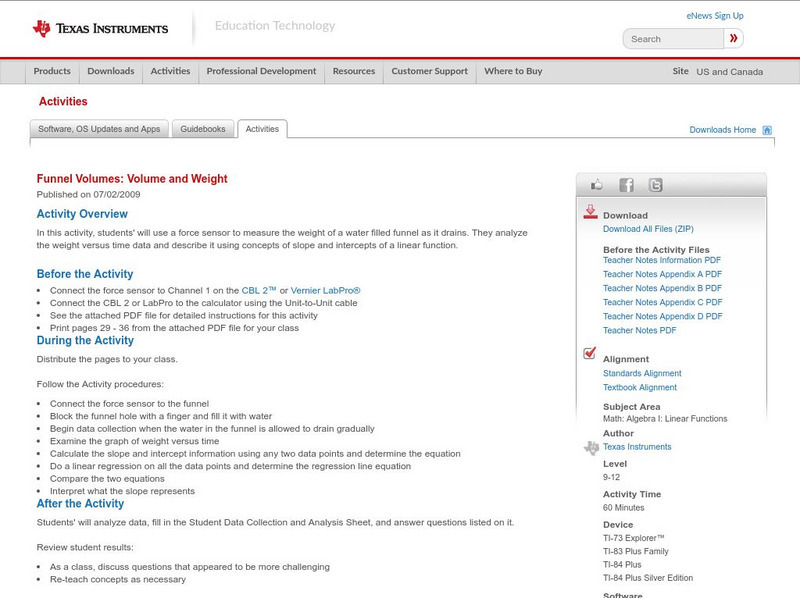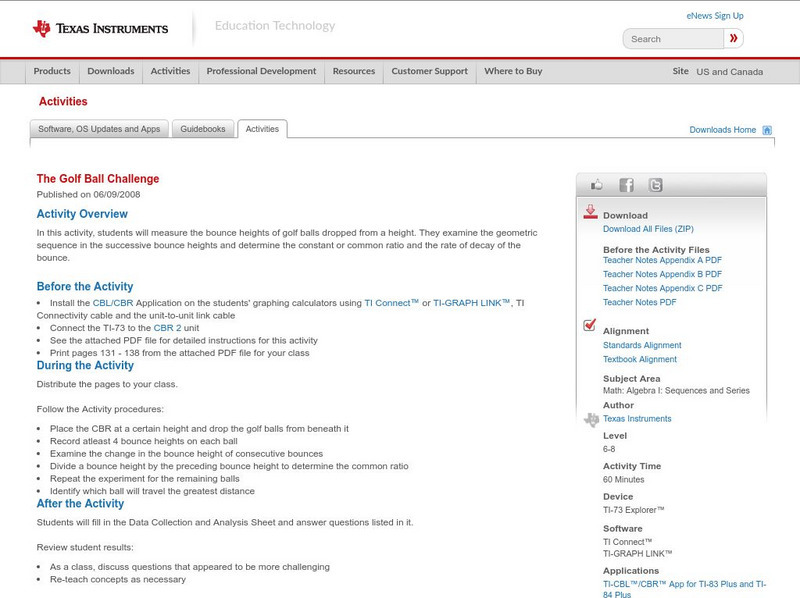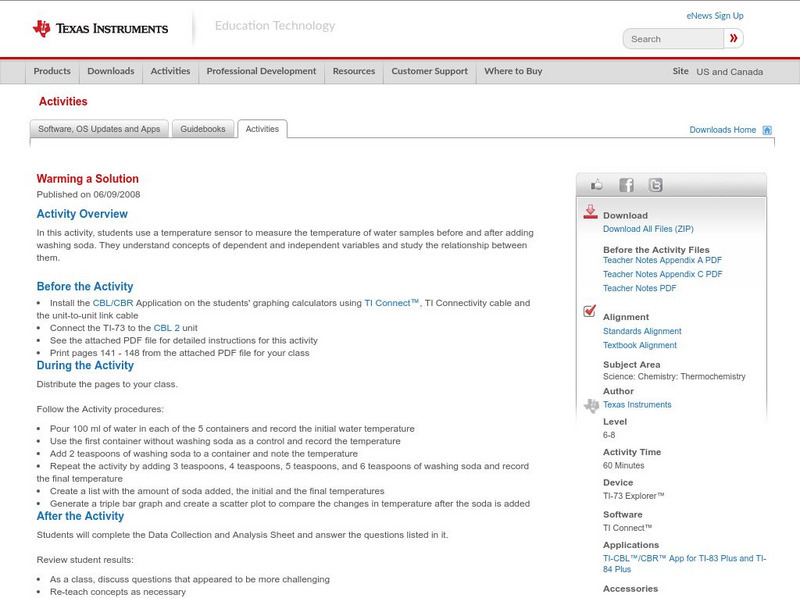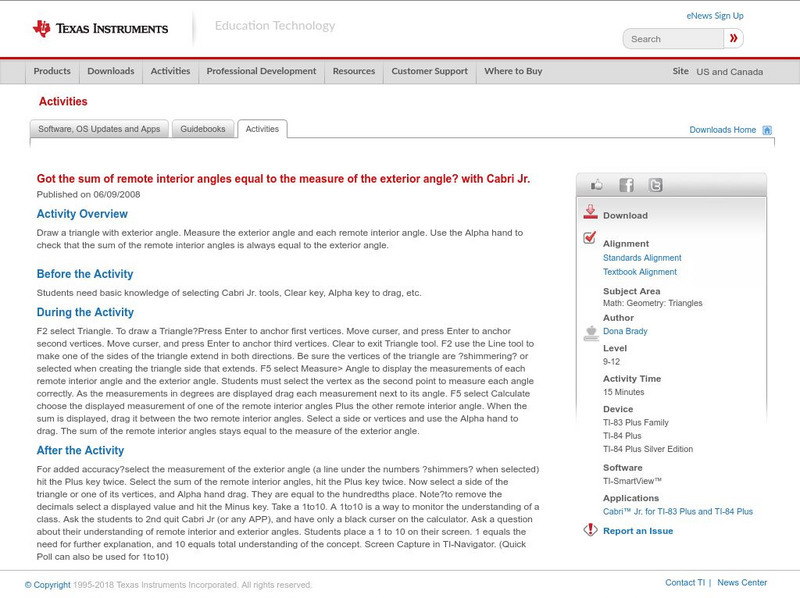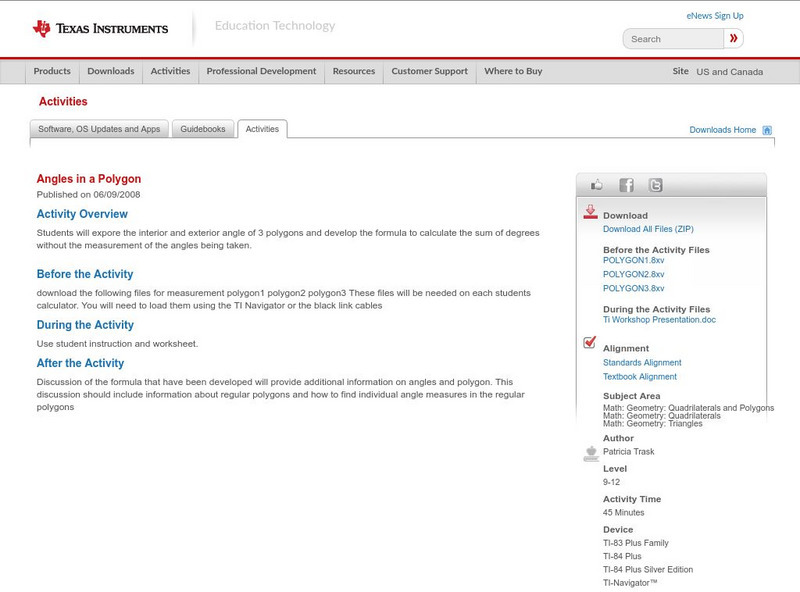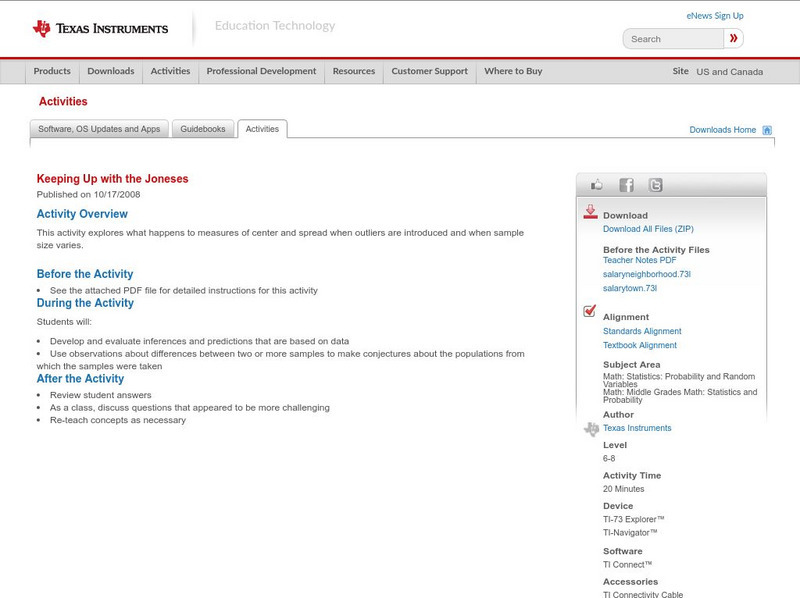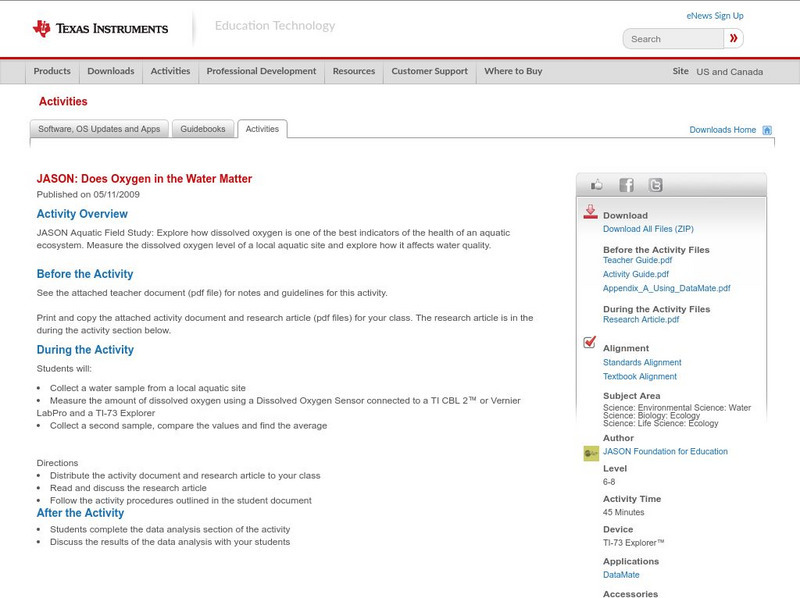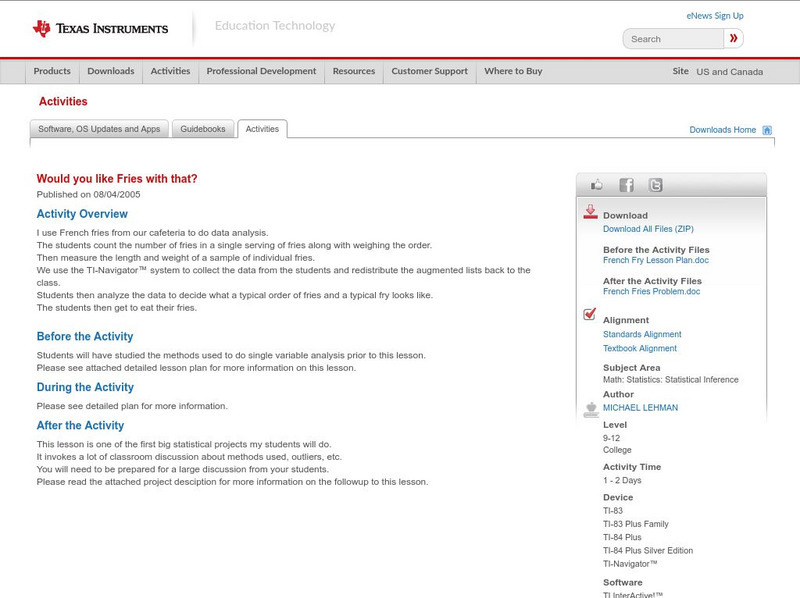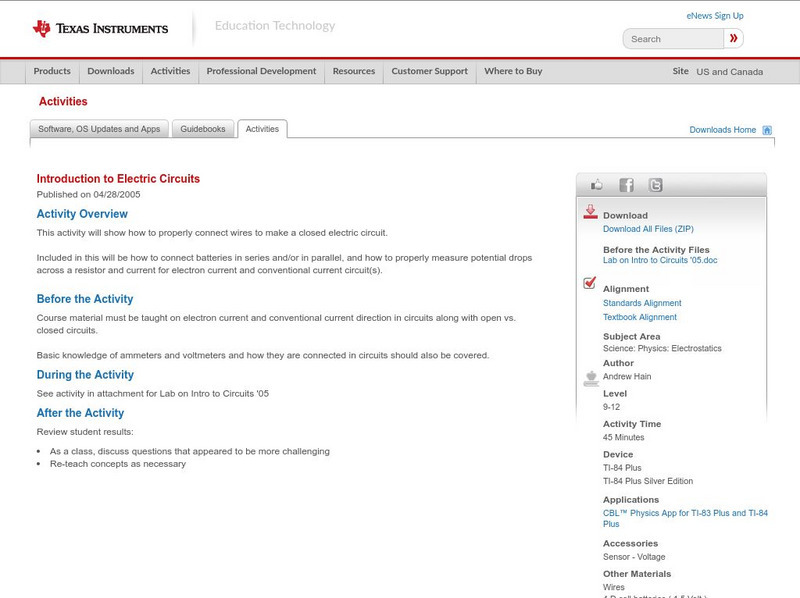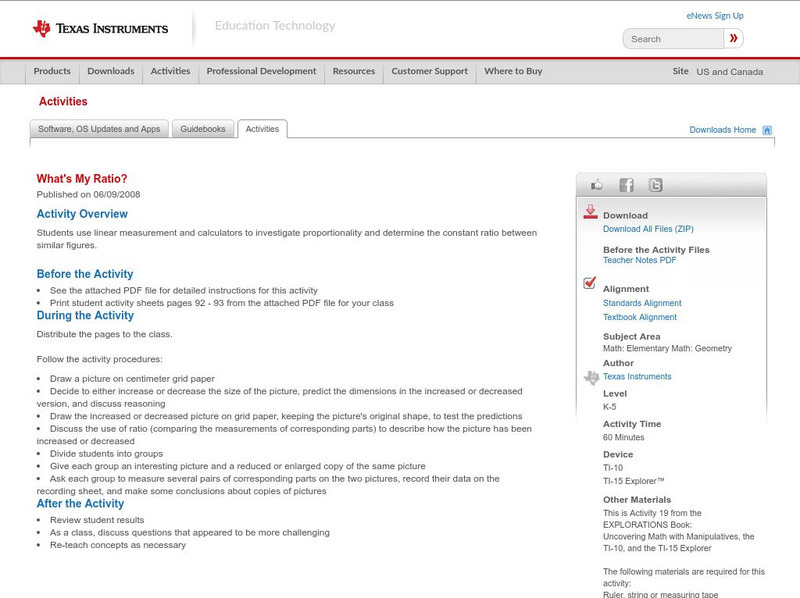Texas Instruments
Texas Instruments: Jason: Mixing Soil and Water Let's Settle This?
Disappearing Wetlands: Investigate how particles settle by measuring the amount of light passing through the water as particles settle. Make connections to the process by which sediment settles out of the Mississippi River to form...
Texas Instruments
Texas Instruments: Heat Transfer by Conduction
The purpose of this activity is to monitor the transfer of heat between 2 materials by measuring the temperature changes in them.
Texas Instruments
Texas Instruments: Funnel Volumes: Volume and Weight
In this activity, students' will use a force sensor to measure the weight of a water filled funnel as it drains. They analyze the weight versus time data and describe it using concepts of slope and intercepts of a linear function.
Texas Instruments
Texas Instruments: The Golf Ball Challenge
In this activity, students will measure the bounce heights of golf balls dropped from a height. They examine the geometric sequence in the successive bounce heights and determine the constant or common ratio and the rate of decay of the...
Texas Instruments
Texas Instruments: Warming a Solution
In this activity, students use a temperature sensor to measure the temperature of water samples before and after adding washing soda. They understand concepts of dependent and independent variables and study the relationship between them.
Texas Instruments
Texas Instruments: Grandparents and Special Friends Day
This lesson was designed for our Grandparents and Special Friends day. It can be used for any visitation day, or an open house. The lesson is designed to review percent of a whole and the sector of the circle representing the percentage....
Texas Instruments
Texas Instruments: Numb3 Rs: It's All Connected
Based off of the hit television show NUMB3RS, this lesson uses students' knowledge of graph theory (networks) to introduce two measures of centrality (how connected a particular node is to the entire network), known as degree centrality...
Texas Instruments
Texas Instruments: Sum of Remote Interior Angles Equals Exterior Angle
Draw a triangle with exterior angle. Measure the exterior angle and each remote interior angle. Use the Alpha hand to check that the sum of the remote interior angles is always equal to the exterior angle.
Texas Instruments
Texas Instruments: Solar Cookers and Easy Data
Students use a TI-84, Easy Temp and Easy Data to measure the quality of solar cookers. Hot dogs are heated under the May sunshine after students design, build and test their own solar cookers.
Texas Instruments
Texas Instruments: Water Quality Tds (Total Dissolved Solids)
In this activity, students can use the Conductivity Probe to measure the Total Dissolved Solids in samples of water.
Texas Instruments
Texas Instruments: Angles in a Polygon
Students will expore the interior and exterior angle of 3 polygons and develop the formula to calculate the sum of degrees without the measurement of the angles being taken.
Texas Instruments
Texas Instruments: Dissolved Oxygen
Students use the Dissolved Oxygen Probe to measure the concentration of dissolved oxygen in water from streams and rivers. They correlate the availability of dissolved oxygen to temperature, pressure, and salinity.
Texas Instruments
Texas Instruments: Keeping Up With the Joneses
This activity explores what happens to measures of center and spread when outliers are introduced and when sample size varies.
Texas Instruments
Texas Instruments: Numb3 Rs: Clearing All Obstacles
Based off of the hit television show NUMB3RS, this lesson has students modeling a mock food fight using projectile motion. This lesson is very technology-intensive, and a CBR2 is used to measure the velocity of an object so that it's...
Texas Instruments
Texas Instruments: Jason: Does Oxygen in the Water Matter
JASON Aquatic Field Study: Explore how dissolved oxygen is one of the best indicators of the health of an aquatic ecosystem. Measure the dissolved oxygen level of a local aquatic site and explore how it affects water quality.
Texas Instruments
Texas Instruments: Would You Like Fries With That?
French fries from your cafeteria to do data analysis. The students count the number of fries in a single serving of fries along with weighing the order, then measure the length and weight of a sample of individual fries. You then use the...
Texas Instruments
Texas Instruments: Frictional Forces
In this activity, students' will use a Dual range force sensor to measure the force required to pull a block across different surfaces. They will examine the results to see when more force is needed to move the block and understand the...
Texas Instruments
Texas Instruments: Voltage From Dry Cells
In this activity, students will use a Voltage sensor to measure the voltage produced by new dry cells of each size. They will also determine whether there is a relationship between dry cell size and voltage.
Texas Instruments
Texas Instruments: Introduction to Electric Circuits
This activity will show how to properly connect wires to make a closed electric circuit. Included in this will be how to connect batteries in series and/or in parallel, and how to properly measure potential drops across a resistor and...
Texas Instruments
Texas Instruments: What's My Ratio?
In this activity, students use linear measurement and calculators to investigate proportionality and determine the constant ratio between similar figures.
Texas Instruments
Texas Instruments: The Magnetic Field in a Slinky
Students use a Magnetic Field Sensor to measure the magnetic field and the current in a solenoid. They explore factors that affect the magnetic field, study how the field varies in parts of the solenoid, and determine the permeability...
Texas Instruments
Texas Instruments: What Does a Buffer Do?
Buffers are solutions that resist a change in pH. In this activity, students will add HCl dropwise to a measured amount of water, monitoring the pH. Students then repeat the process, using a simple buffer prepared by combining baking...
Texas Instruments
Texas Instruments: Math Today the New Color of Money
The USA TODAY Snapshot allows students to use scientific notation with real-life data. Students will work with large numbers when determining the height of a stack of $20 bills. Unit conversion will be used from one unit of measure to...
Texas Instruments
Texas Instruments: Is There a Relationship Between Your Fist and Shoe Size?
Students will measure the circumference of their fist and list their shoe size. The lists will be loaded using TI-Navigator in the activity center.




